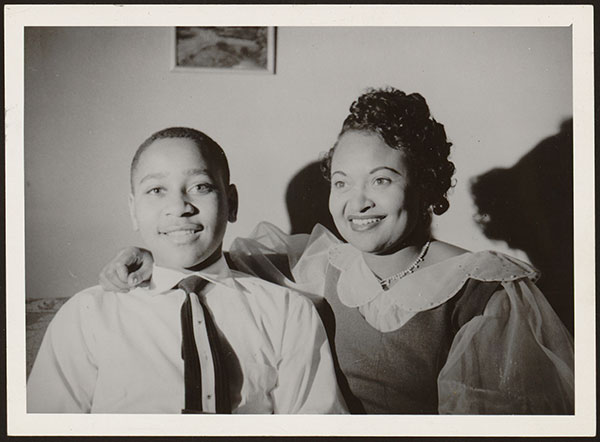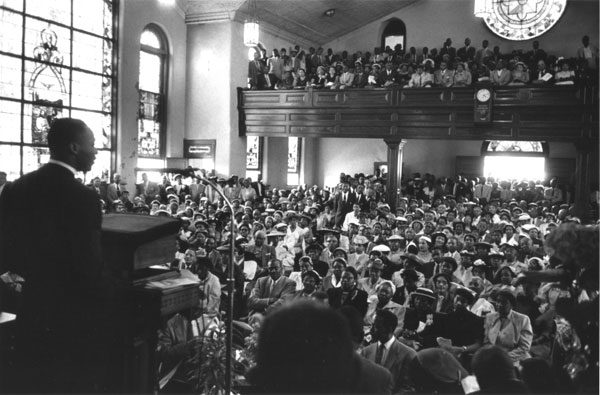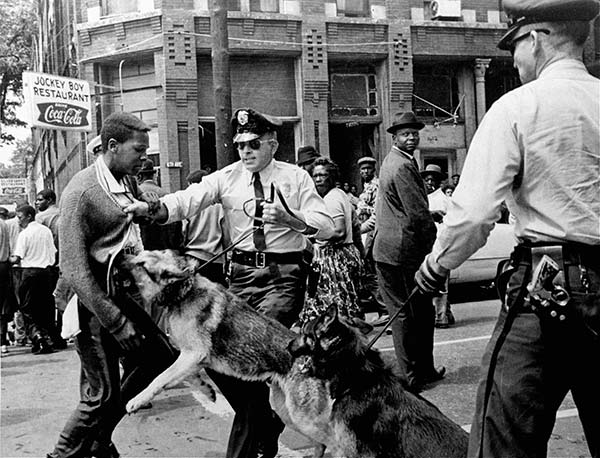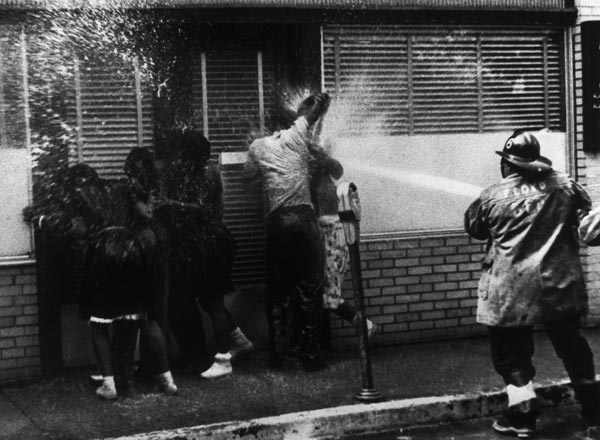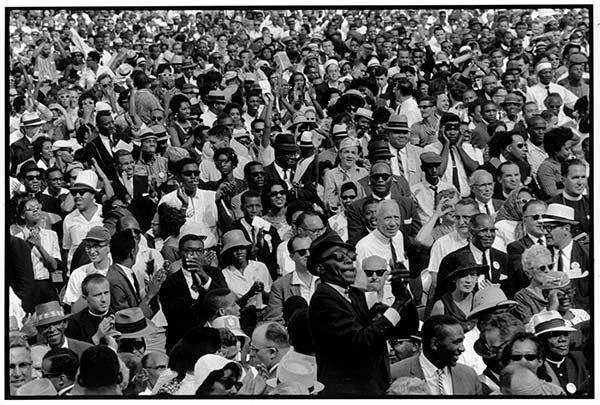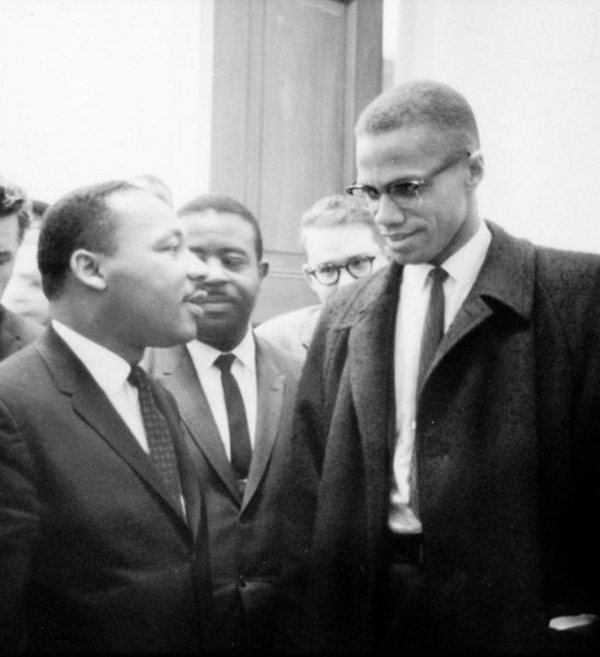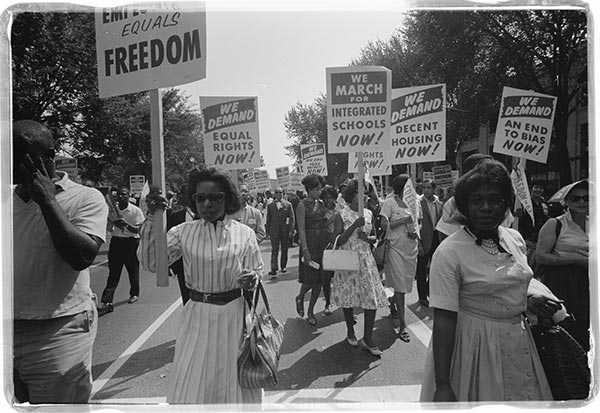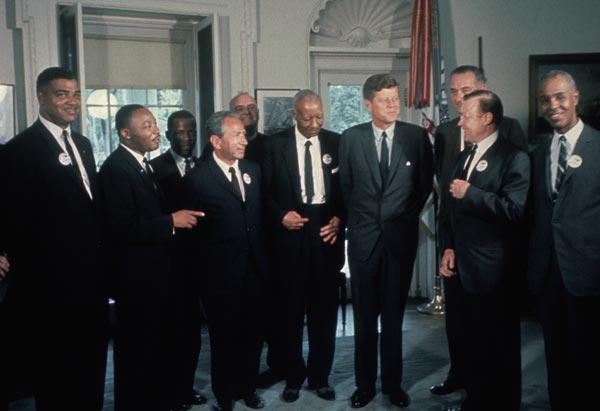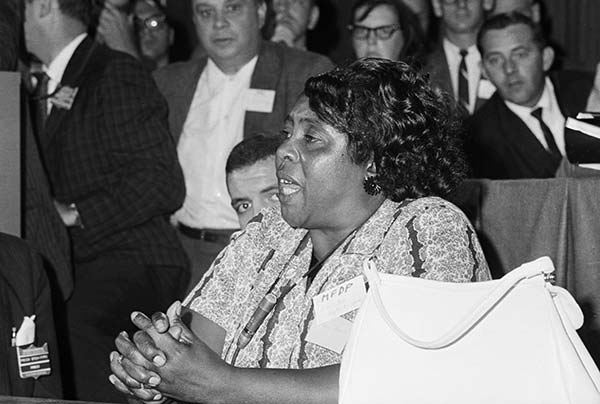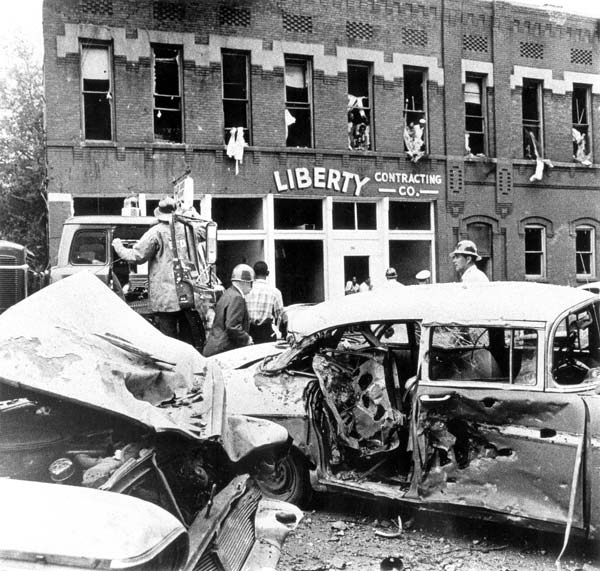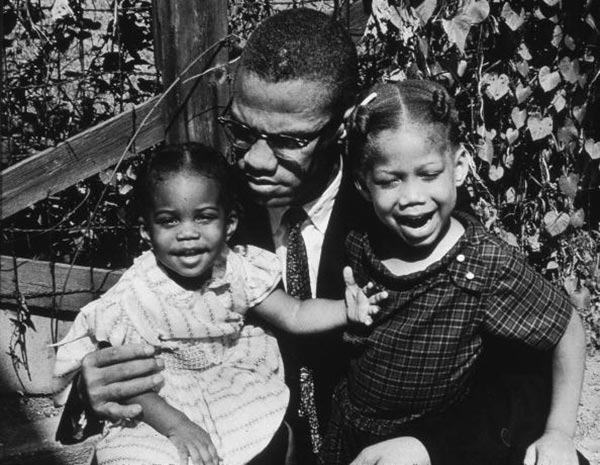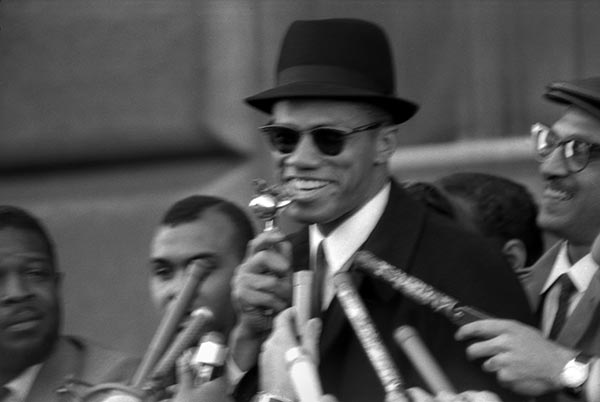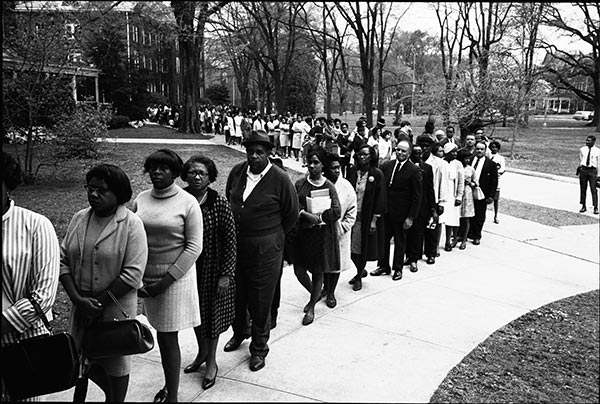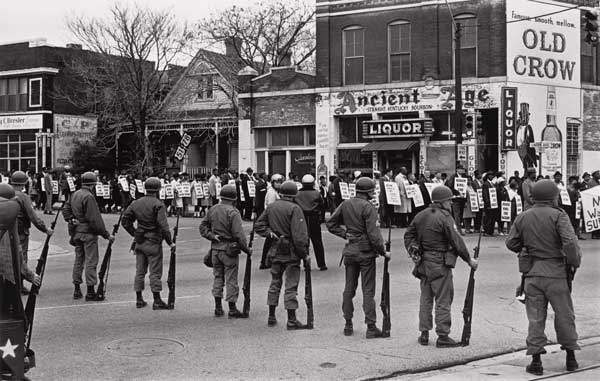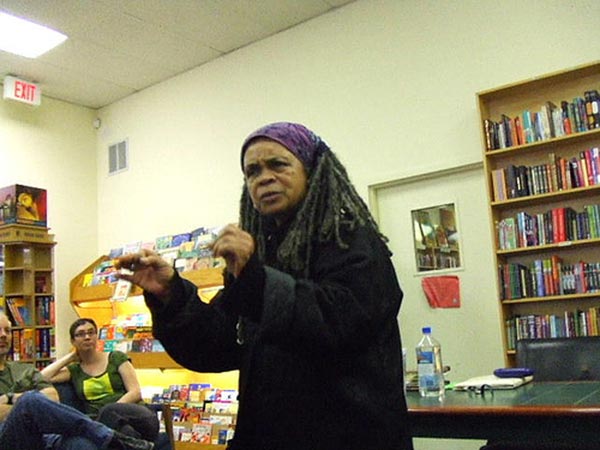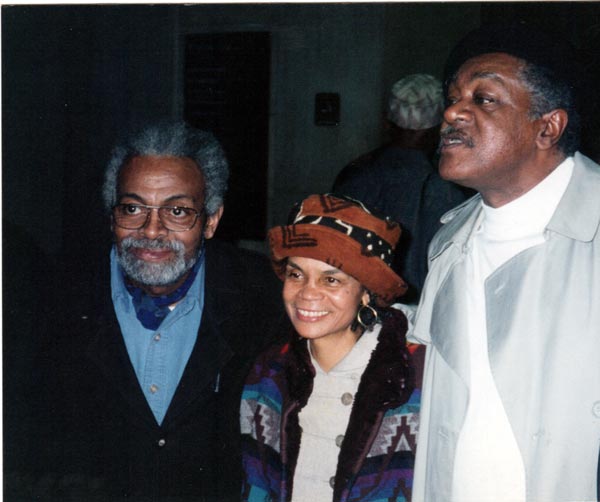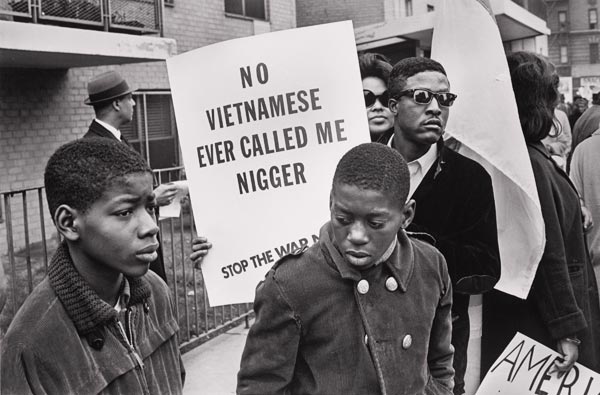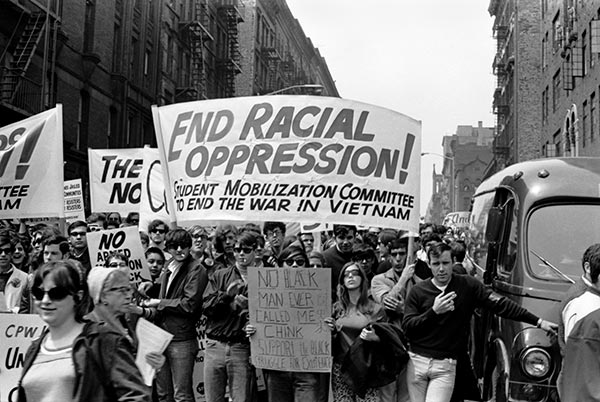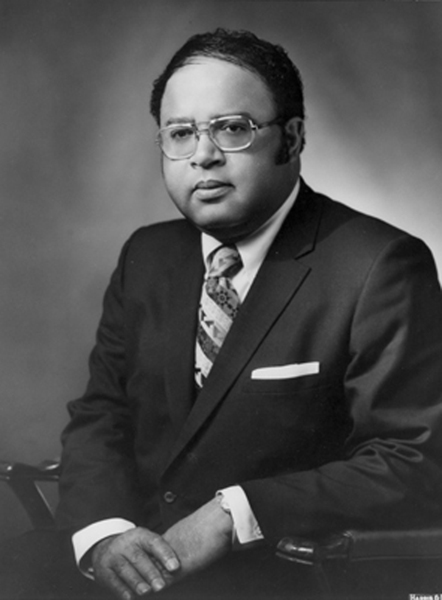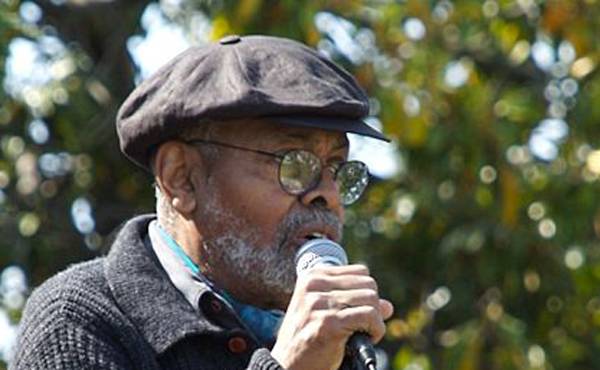Image Archive
NAACP chief Executive Roy Wilkins presents the Freedom Bell Award to Judge Thurgood Marshall.
Marshall had been the legal council for the NAACP on Brown v. Board of Education and in 1967 would become the first black U.S. Supreme Court Justice. Source: CORBIS.
Marshall had been the legal council for the NAACP on Brown v. Board of Education and in 1967 would become the first black U.S. Supreme Court Justice. Source: CORBIS.
Photo location:
SECTION 01
:
School Desegregation Movement:
Brown vs. The Board Of Education
A portrait of Mamie Bradley and her son Emmett Till.
This picture was taken before Emmett left for Mississippi, 1955. Source: Library of Congress Prints and Photographs Division.
This picture was taken before Emmett left for Mississippi, 1955. Source: Library of Congress Prints and Photographs Division.
Photo location:
SECTION 02
:
Emmett Till
Walking to work, 1956.
Thousands of black commuters are shown walking long distances to work instead of riding the buses during the Montgomery bus boycott, 1956. Source: Don Cravens/Time Life/Getty Images.
Thousands of black commuters are shown walking long distances to work instead of riding the buses during the Montgomery bus boycott, 1956. Source: Don Cravens/Time Life/Getty Images.
Photo location:
SECTION 03
:
Montgomery Bus Boycott
Martin Luther King, Jr. speaking in church during the Montgomery bus boycott.
Churches played a key role in organizing the boycott. Here, Martin Luther King, Jr. is encouraging churchgoers to continue the boycott. 1956. Source: Dan Weiner, courtesy of Sandra Weiner.
Churches played a key role in organizing the boycott. Here, Martin Luther King, Jr. is encouraging churchgoers to continue the boycott. 1956. Source: Dan Weiner, courtesy of Sandra Weiner.
Photo location:
SECTION 03
:
Montgomery Bus Boycott
Police dogs attacking a teenager.
A 17-year-old boy, who refuses to yield to the city ordinance that denied city residents the right to public parades, is attacked by police dogs in Birmingham, Alabama, May 4, 1963. Source: AP Photo.
A 17-year-old boy, who refuses to yield to the city ordinance that denied city residents the right to public parades, is attacked by police dogs in Birmingham, Alabama, May 4, 1963. Source: AP Photo.
Photo location:
SECTION 05
:
The Birmingham Desegregation Campaign
Violent techniques used on peaceful protesters in 1963.
During desegregation protests in 1963, city officials, at the order of the brutally violent police commissioner Eugene "Bull" Conner, used fire hoses and clubs on un-armed, nonviolent protesters. Pictures like this one raised global awareness for the civil rights movement. Source: AP Photo.
During desegregation protests in 1963, city officials, at the order of the brutally violent police commissioner Eugene "Bull" Conner, used fire hoses and clubs on un-armed, nonviolent protesters. Pictures like this one raised global awareness for the civil rights movement. Source: AP Photo.
Photo location:
SECTION 05
:
The Birmingham Desegregation Campaign
At the nation's capital, 1963.
On August 28, 1963, thousands of activists, community leaders and citizens convened on the nation's capital to hear the words of some of the most prominent civil rights leaders. Source: Bruce Davidson/Magnum Photos.
On August 28, 1963, thousands of activists, community leaders and citizens convened on the nation's capital to hear the words of some of the most prominent civil rights leaders. Source: Bruce Davidson/Magnum Photos.
Photo location:
SECTION 06
:
The March on Washington and the Civil Rights Act
Martin Luther King, Jr. and Malcolm X meet during a Senate Debate on the Civil Rights Act of 1964.
Source: Marion S. Trikosko, March 1964, Library of Congress Prints and Photographs Division, Washington, DC.
Source: Marion S. Trikosko, March 1964, Library of Congress Prints and Photographs Division, Washington, DC.
Photo location:
SECTION 06
:
The March on Washington and the Civil Rights Act
African American protest for equal rights, 1963.
A procession of African Americans carrying signs for equal rights, integrated schools, decent housing, and an end to bias, August 28, 1963. Source: Warren K. Leffler, Library of Congress Prints and Photographs Division.
A procession of African Americans carrying signs for equal rights, integrated schools, decent housing, and an end to bias, August 28, 1963. Source: Warren K. Leffler, Library of Congress Prints and Photographs Division.
Photo location:
SECTION 06
:
The March on Washington and the Civil Rights Act
Civil rights leaders meet with President Kennedy and Vice President Johnson.
Civil rights leaders, including Martin Luther King, Jr., A. Philip Randolph, Roy Wilkins, and John Lewis meet with President Kennedy and Vice President Johnson to discuss Civil Rights, August 28, 1963. Source: Records of the NAACP, Library of Congress.
Civil rights leaders, including Martin Luther King, Jr., A. Philip Randolph, Roy Wilkins, and John Lewis meet with President Kennedy and Vice President Johnson to discuss Civil Rights, August 28, 1963. Source: Records of the NAACP, Library of Congress.
Photo location:
SECTION 06
:
The March on Washington and the Civil Rights Act
Fannie Lou Hamer.
As the spokeswoman for the Mississippi Freedom Democratic Party, Fannie Lou Hamer traveled to Atlantic City, NJ, with other activists for the Democratic National Convention, August 24, 1964. Although being denied official credentials, the symbolic party became a catalyst for independent black political organizations throughout the country. Source: Warren K. Leffler, Library of Congress Prints and Photographs Division.
As the spokeswoman for the Mississippi Freedom Democratic Party, Fannie Lou Hamer traveled to Atlantic City, NJ, with other activists for the Democratic National Convention, August 24, 1964. Although being denied official credentials, the symbolic party became a catalyst for independent black political organizations throughout the country. Source: Warren K. Leffler, Library of Congress Prints and Photographs Division.
Photo location:
SECTION 07
:
Mississippi Freedom Summer
Sixteenth Street Baptist Church bombing.
The bombing of the Sixteenth Street Baptist Church in Birmingham, Alabama on September 17, 1963 caused significant damage to the Church and neighboring buildings. Source: Courtesy of Birmingham Public Library, Department of Archives and Manuscripts.
The bombing of the Sixteenth Street Baptist Church in Birmingham, Alabama on September 17, 1963 caused significant damage to the Church and neighboring buildings. Source: Courtesy of Birmingham Public Library, Department of Archives and Manuscripts.
Photo location:
SECTION 07
:
Mississippi Freedom Summer
Malcolm X with Family, 1963.
Then a minister for the Nation of Islam, Malcolm X Shabazz plays with two of his daughters, 1962. Source: Photo by Robert L. Haggins/Time Life Pictures/Getty Images.
Then a minister for the Nation of Islam, Malcolm X Shabazz plays with two of his daughters, 1962. Source: Photo by Robert L. Haggins/Time Life Pictures/Getty Images.
Photo location:
SECTION 08
:
Malcolm X
Malcolm X at a NYC Rally, 1964.
Malcolm X speaking at a NYC rally related to the citywide boycott of schools, February or March 1964. Source: Courtesy of Builder Levy, photographer.
Malcolm X speaking at a NYC rally related to the citywide boycott of schools, February or March 1964. Source: Courtesy of Builder Levy, photographer.
Photo location:
SECTION 08
:
Malcolm X
Selma Police arrest peaceful demonstrators.
Selma police arresting nonviolent marchers during their first attempt to march from Selma to Montgomery, March 7, 1965. The violence against marchers prompted President Johnson to submit a proposal for a strong Voting Rights Act. Source: Alabama Sovereignty Commission, Administrative files, SG13843, folder 8, Alabama Department of Archives and History, Montgomery Alabama.
Selma police arresting nonviolent marchers during their first attempt to march from Selma to Montgomery, March 7, 1965. The violence against marchers prompted President Johnson to submit a proposal for a strong Voting Rights Act. Source: Alabama Sovereignty Commission, Administrative files, SG13843, folder 8, Alabama Department of Archives and History, Montgomery Alabama.
Photo location:
SECTION 09
:
Civil Rights, Voting Rights, and the Selma March
Mourners wait to pay respects to Rev. King.
Over 50,000 citizens participated in the funeral procession for the fallen civil rights leader. Source: Constantine Manos/Magnum Photos.
Over 50,000 citizens participated in the funeral procession for the fallen civil rights leader. Source: Constantine Manos/Magnum Photos.
Photo location:
SECTION 10
:
Urban Unrest and Socioeconomic Conditions
Burned streets of Washington D.C., 1968.
Following the assassination of Martin Luther King, Jr., violence erupted across the nation's cities as people reacted to the loss of the civil rights leader. Here, the national guard patrols the burned streets of Washington D.C., 1968. Source: Leonard Freed/Magnum Photos.
Following the assassination of Martin Luther King, Jr., violence erupted across the nation's cities as people reacted to the loss of the civil rights leader. Here, the national guard patrols the burned streets of Washington D.C., 1968. Source: Leonard Freed/Magnum Photos.
Photo location:
SECTION 10
:
Urban Unrest and Socioeconomic Conditions
Sanitation workers from Memphis march.
Following the assassination of Martin Luther King, Jr., the sanitation workers he had come to Memphis to support led the National Martin Luther King, Jr. Memorial March for Union Justice and to End Racism, April 27, 1968. Source: Courtesy of Builder Levy, photographer.
Following the assassination of Martin Luther King, Jr., the sanitation workers he had come to Memphis to support led the National Martin Luther King, Jr. Memorial March for Union Justice and to End Racism, April 27, 1968. Source: Courtesy of Builder Levy, photographer.
Photo location:
SECTION 10
:
Urban Unrest and Socioeconomic Conditions
Members of the Black Panther Party demonstrating outside a New York City courthouse, April 11, 1969.
Source: Hulton Archive/Getty Images.
Source: Hulton Archive/Getty Images.
Photo location:
SECTION 11
:
Black Power
Poet Sonia Sanchez , 2006.
Source: Courtesy of Stephen Bess, photographer.
Source: Courtesy of Stephen Bess, photographer.
Photo location:
SECTION 12
:
Black Arts Movement
Sonia Sanchez and Amiri Baraka, and others, circa 1996.
Source: Courtesy of M. Songhai, photographer.
Source: Courtesy of M. Songhai, photographer.
Photo location:
SECTION 12
:
Black Arts Movement
Demonstrators at the Harlem Peace March to End Racial Oppression, 1967.
A young demonstrator carries a placard that reads "No Vietnamese Ever Called Me Nigger" at the Harlem Peace March to End Racial Oppression on April 27, 1967. The statement was taken from boxer Muhammad Ali's original statement about his refusal to participate in the Vietnam War, "Ain't no Vietcong ever called me nigger." Source: Courtesy of Builder Levy, photographer.
A young demonstrator carries a placard that reads "No Vietnamese Ever Called Me Nigger" at the Harlem Peace March to End Racial Oppression on April 27, 1967. The statement was taken from boxer Muhammad Ali's original statement about his refusal to participate in the Vietnam War, "Ain't no Vietcong ever called me nigger." Source: Courtesy of Builder Levy, photographer.
Photo location:
SECTION 13
:
Black Opposition to Vietnam
Harlem Peace March to End Racial Oppression, 1967.
A young man carries a placard that states "No Black Man Ever Called Me Chink" during the Harlem Peace March to End Racial Oppression on April 27, 1967. The statement was taken from boxer/activist Muhammad Ali's original statement about his refusal to participate in the Vietnam War, "Ain't no Vietcong ever called me nigger." Source: Courtesy of Builder Levy, photographer.
A young man carries a placard that states "No Black Man Ever Called Me Chink" during the Harlem Peace March to End Racial Oppression on April 27, 1967. The statement was taken from boxer/activist Muhammad Ali's original statement about his refusal to participate in the Vietnam War, "Ain't no Vietcong ever called me nigger." Source: Courtesy of Builder Levy, photographer.
Photo location:
SECTION 13
:
Black Opposition to Vietnam
Charles Diggs, member of the United States House of Representatives.
Source: National Archives and Records Administration.
Source: National Archives and Records Administration.
Photo location:
SECTION 14
:
New Black Politics
Amiri Baraka addressing the Malcom X Festival in San Antonio Park, Oakland, California.
Source: David Sasaki.
Source: David Sasaki.
Photo location:
SECTION 14
:
New Black Politics


